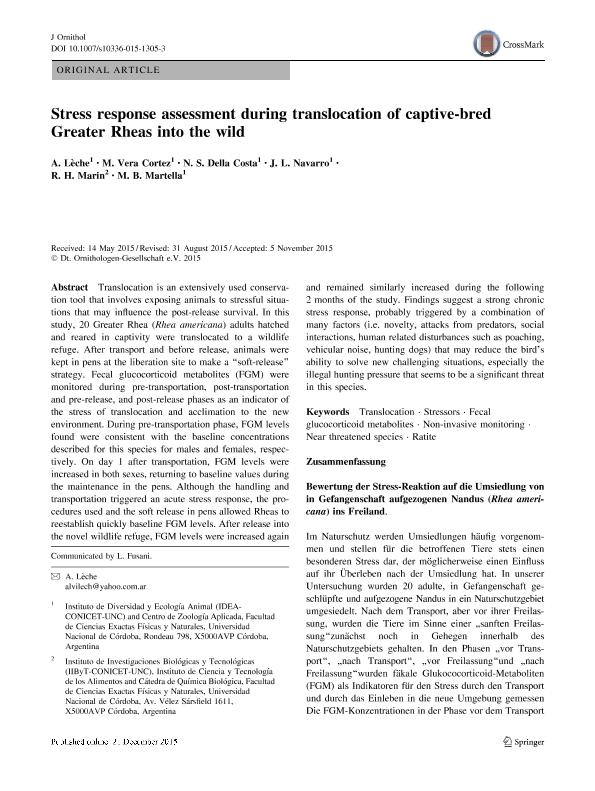Mostrar el registro sencillo del ítem
dc.contributor.author
Leche, Alvina

dc.contributor.author
Vera Cortez, Marilina

dc.contributor.author
Della Costa, Natalia Soledad

dc.contributor.author
Navarro, Joaquin Luis

dc.contributor.author
Marin, Raul Hector

dc.contributor.author
Martella, Monica Beatriz

dc.date.available
2016-11-03T15:59:25Z
dc.date.issued
2015-11
dc.identifier.citation
Leche, Alvina; Vera Cortez, Marilina; Della Costa, Natalia Soledad; Navarro, Joaquin Luis; Marin, Raul Hector; et al.; Stress response assessment during translocation of captive-bred Greater Rheas into the wild; Springer; Journal of Ornithology; 157; 2; 11-2015; 599-607
dc.identifier.issn
2193-7206
dc.identifier.uri
http://hdl.handle.net/11336/7932
dc.description.abstract
Translocation is an extensively used conservationtool that involves exposing animals to stressful situationsthat may influence the post-release survival. In thisstudy, 20 Greater Rhea (Rhea americana) adults hatchedand reared in captivity were translocated to a wildliferefuge. After transport and before release, animals werekept in pens at the liberation site to make a ??soft-release??strategy. Fecal glucocorticoid metabolites (FGM) weremonitored during pre-transportation, post-transportationand pre-release, and post-release phases as an indicator ofthe stress of translocation and acclimation to the newenvironment. During pre-transportation phase, FGM levelsfound were consistent with the baseline concentrationsdescribed for this species for males and females, respectively.On day 1 after transportation, FGM levels wereincreased in both sexes, returning to baseline values duringthe maintenance in the pens. Although the handling andtransportation triggered an acute stress response, the proceduresused and the soft release in pens allowed Rheas toreestablish quickly baseline FGM levels. After release intothe novel wildlife refuge, FGM levels were increased again and remained similarly increased during the following2 months of the study. Findings suggest a strong chronicstress response, probably triggered by a combination ofmany factors (i.e. novelty, attacks from predators, socialinteractions, human related disturbances such as poaching,vehicular noise, hunting dogs) that may reduce the bird?sability to solve new challenging situations, especially theillegal hunting pressure that seems to be a significant threatin this species.
dc.format
application/pdf
dc.language.iso
eng
dc.publisher
Springer

dc.rights
info:eu-repo/semantics/openAccess
dc.rights.uri
https://creativecommons.org/licenses/by-nc-sa/2.5/ar/
dc.subject
TRANSLOCATION
dc.subject
STRESSORS
dc.subject
FECAL GLUCOCORTICOID METABOLITES
dc.subject
NON-INVASIVE MONITORING
dc.subject
NEAR THREATENED SPECIES
dc.subject
RATITE
dc.subject.classification
Zoología, Ornitología, Entomología, Etología

dc.subject.classification
Ciencias Biológicas

dc.subject.classification
CIENCIAS NATURALES Y EXACTAS

dc.subject.classification
Conservación de la Biodiversidad

dc.subject.classification
Ciencias Biológicas

dc.subject.classification
CIENCIAS NATURALES Y EXACTAS

dc.subject.classification
Otras Ciencias Veterinarias

dc.subject.classification
Ciencias Veterinarias

dc.subject.classification
CIENCIAS AGRÍCOLAS

dc.title
Stress response assessment during translocation of captive-bred Greater Rheas into the wild
dc.type
info:eu-repo/semantics/article
dc.type
info:ar-repo/semantics/artículo
dc.type
info:eu-repo/semantics/publishedVersion
dc.date.updated
2016-11-02T18:15:42Z
dc.journal.volume
157
dc.journal.number
2
dc.journal.pagination
599-607
dc.journal.pais
Alemania

dc.journal.ciudad
Berlín
dc.description.fil
Fil: Leche, Alvina. Consejo Nacional de Investigaciones Cientificas y Tecnicas. Centro Cientifico Tecnologico Cordoba. Instituto de Diversidad y Ecologia Animal; Argentina
dc.description.fil
Fil: Vera Cortez, Marilina. Consejo Nacional de Investigaciones Cientificas y Tecnicas. Centro Cientifico Tecnologico Cordoba. Instituto de Diversidad y Ecologia Animal; Argentina
dc.description.fil
Fil: Della Costa, Natalia Soledad. Consejo Nacional de Investigaciones Cientificas y Tecnicas. Centro Cientifico Tecnologico Cordoba. Instituto de Diversidad y Ecologia Animal; Argentina
dc.description.fil
Fil: Navarro, Joaquin Luis. Consejo Nacional de Investigaciones Cientificas y Tecnicas. Centro Cientifico Tecnologico Cordoba. Instituto de Diversidad y Ecologia Animal; Argentina
dc.description.fil
Fil: Marin, Raul Hector. Consejo Nacional de Investigaciones Científicas y Técnicas. Centro Científico Tecnológico Córdoba. Instituto de Investigaciones Biológicas y Tecnológicas; Argentina
dc.description.fil
Fil: Martella, Monica Beatriz. Consejo Nacional de Investigaciones Cientificas y Tecnicas. Centro Cientifico Tecnologico Cordoba. Instituto de Diversidad y Ecologia Animal; Argentina
dc.journal.title
Journal of Ornithology
dc.relation.alternativeid
info:eu-repo/semantics/altIdentifier/url/http://link.springer.com/article/10.1007/s10336-015-1305-3
dc.relation.alternativeid
info:eu-repo/semantics/altIdentifier/doi/http://dx.doi.org/10.1007/s10336-015-1305-3
Archivos asociados
